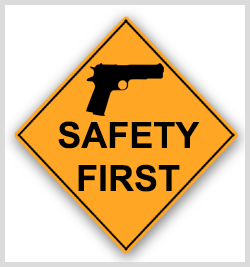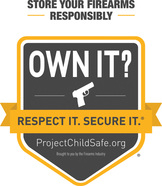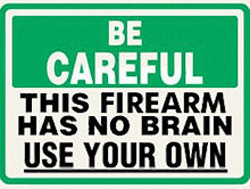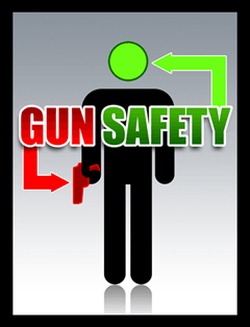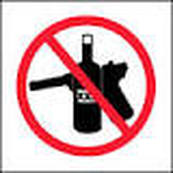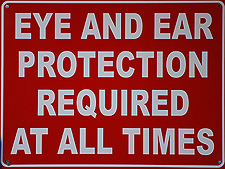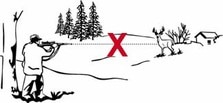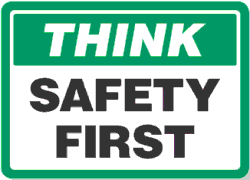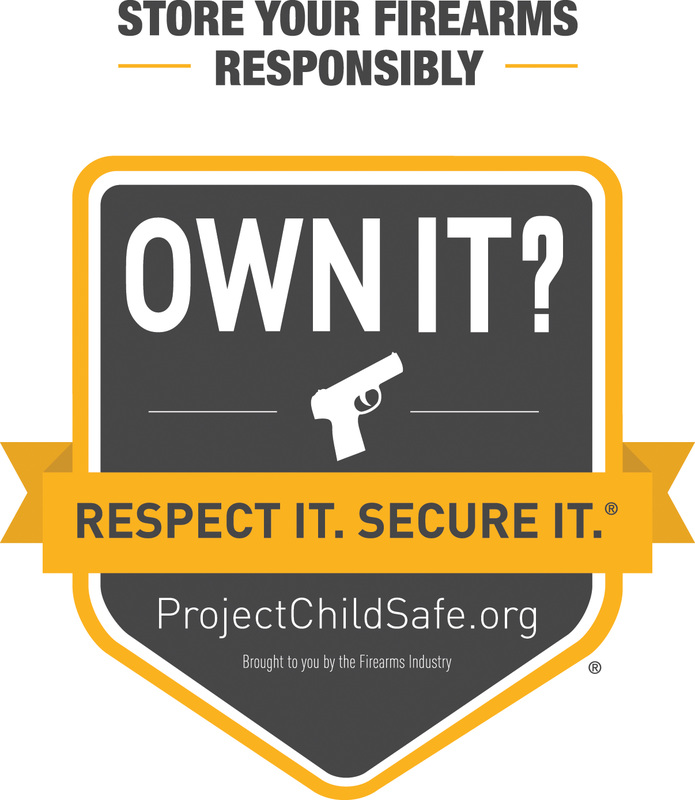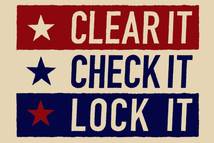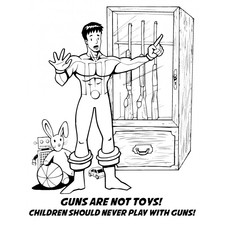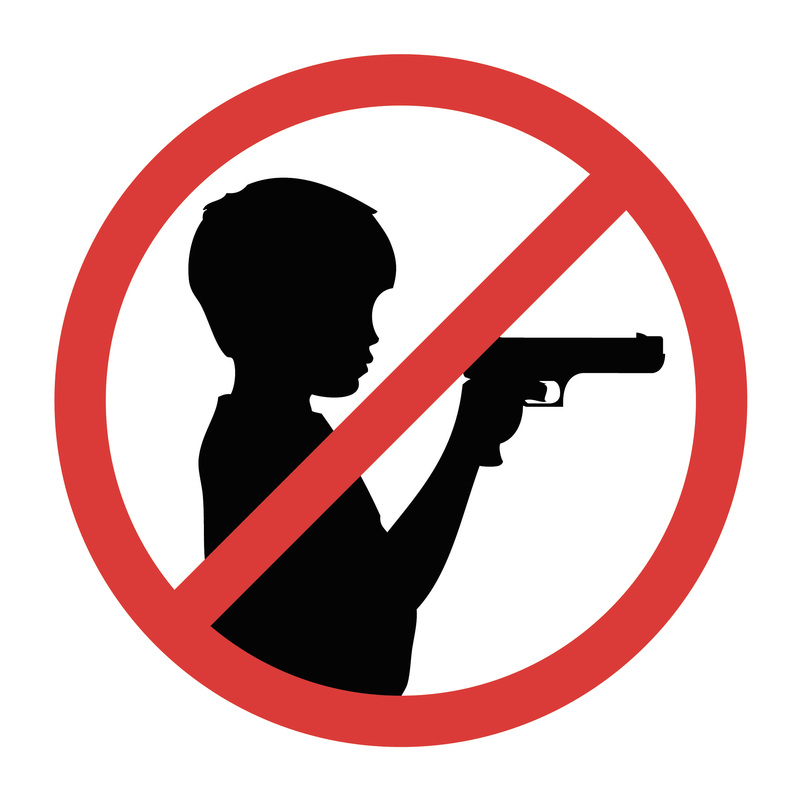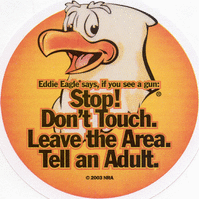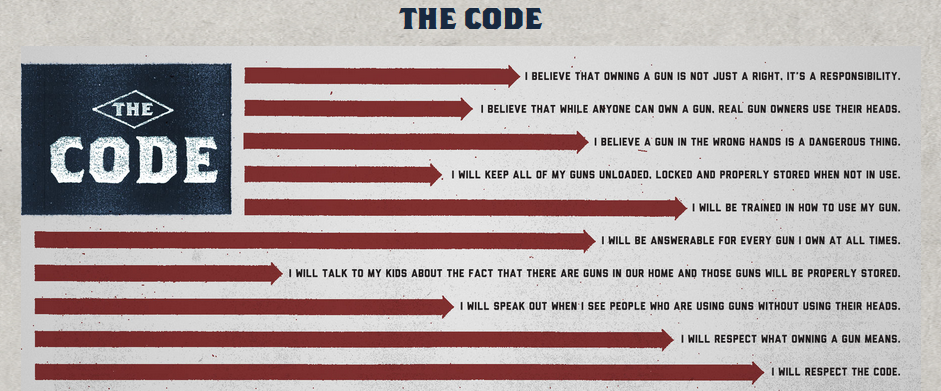Firearm Safety - - - Rules to Live By
|
Before covering the safety rules, a note about firearms, Hollywood movies and TV.
Every firearm user should completely disregard the barrage of BS the mass media has been entertaining them with for years, as any kind of valid information on correct, legal or safe usage of firearms. Employing the misinformation used by movies and TV in real life firearm situations will surely get you or someone else killed or jailed. Reality is a different set of facts and consequences from those portrayed in the entertainment world. Reality's consequences are real. If that statement sounded redundant, it was intended to reinforce the point that there is a serious responsibility placed on every firearm owner, and the consequences of shrugging that responsibility in the real world are often permanent and unpleasant. Living in a community requires abiding by specific rules we all agree on, and that it's members conduct themselves in a manner where everyone treats each other with mutual respect. Aside from mutual respect, firearm owners also have rules, safety rules, for living in their community. The firearms community is not just a place where safety is a rule, it is a state of mind and a way of life, a necessity that has become an active choice each member lives up to when assuming membership in this community. This page provides you with several versions of firearm safety rules. All share the same core rules. If you don't already have a copy, you are encouraged to download a copy of any or all of the safety rules from the attached documents at the end of each set of rules on this page, so you can learn the rules (NRA rules and Jeff Cooper's rules being the best two sets of core rules to start with). As a firearm owner you must commit the basic rules to memory. The user must follow all of the firearm safety rules at all times; ALL OF THE RULES MUST BE OBSERVED ALL OF THE TIME. There are NO EXCEPTIONS, only NEEDLESS TRAGEDIES, when any of these rules are ignored. This fact cannot be overemphasized. Understand that safety has no shortcuts (shortcuts are always met with dire consequences), so take the time to learn the rules, it is an essential first step toward responsible firearm ownership. You are responsible for your actions when using a firearm. Safety is everyone's responsibility. One second of folly will lead to a lifetime of regret. Negligence with or misuse of a firearm can create very unforgiving circumstances. We all know that regret is the gift that keeps on giving long after everything is said and done. Live a life that promotes safety and imprints this character on new shooters that enter the firearms community. Handling/usage of firearms is a cognizant activity, which requires the user to know the status (loaded/unloaded) of their firearm at all times and constant awareness of their surroundings. "Make safety a habit" is echoed in the firearms community, and other communities (SCUBA diving, sky diving, construction, truck driving, etc.) where safety awareness protocols are a necessity for successfully accomplishing these activities. But safety needs to be more than a habit. Merriam-Webster defines a habit as a usual way of behaving: something that a person does often in a regular and repeated way. This is essentially what we aspire to achieve with all firearm users in regard to safety. The problem with a habit is that it is often ingrained to such an extent, that it becomes something we do without consciously thinking about it. Typically, I turn off the kitchen light on my way out to work in the morning, without thinking about it. While driving to work, I can't remember specifically turning off that light, but trust that I did since it has become a habit. Can I take that same non-cognizant approach to firearm safety and trust my ingrained habits? The answer: Sometimes when I get home after work, I find that I didn't turn off the kitchen light on the way out in the morning (exceptionally rare, but it has happened). Safety needs to be more than a habit, but what should it be? Merriam-Webster defines a ritual as always done in a particular situation and in the same way each time: done in accordance with social custom or normal protocol. Think of a habit where after the act is learned, it becomes ingrained and to the point where there is no cognitive participation. Think of a ritual, such as a complex religious ritual, or the protocols of safe firearm handling (which we keep simple by comparison for obvious reasons), where even though the participant(s) may know the ritual, but conducting the ritual requires them to be fully cognizant and actively engaged in what they are doing. The (ritual) protocols are strictly followed in a specified order the same way each time, every time, with no deviation from protocol. There is no "autopilot" or "zone-out" in the ritual approach to safety, because what's on your mind is the step you are actually doing at that moment, the step you just completed and the step you will proceed to next, with no variability in any of the steps of the established protocol. Safety needs to be approached as a ritual, with an active cognizant engagement by the firearms user/handler, which keeps them focused in "the now" and strict adherence to clearly set protocols they must follow with no deviation from any of the details in this procedure. (Special thanks to Instructor/Trainer Kenneth Murray for this valuable and thoughtful approach to safety). Shooting is supposed to be (first and foremost) a safe and (secondly) fun activity, if it's not, then you are not conducting yourself safely. All novices will need guidance from an experienced instructor to provide proper mentoring to enable the novice to become a responsible and safe shooter. Learning correct safety and handling characteristics from the beginning is paramount in setting a standard that will be (imprinted on and) strictly followed throughout the lifetime of a (new) firearm owner. Reckless/unsafe handling habits once ingrained are difficult to unlearn, and that's why it is so essential to receive proper instruction in learning the safe handling and operation of a firearm from the start. If you don't know, don't try to do it yourself. Please contact FITG if you require instruction in the safe use of firearms or would like to learn (really learn) how shoot. This is why we are here, this is what we do, professional firearms instruction, always with the emphasis on safety. There is a definitive relationship between safety and training. Understand that safety is an integral part of training as training is an integral part of safety. A well educated firearms user understands this relationship. If you haven't trained, you haven't learned. The legacy of safety is its value and ritual being impressed upon the character of many during a long life, well lived, where none were fouled. Safety is everyone's responsibility. Think safety, your life and the lives of others depend on it. Safety and Equipment (PPE) - - - Stuff You Gotta Wear
When covering the core aspect of safety, mainly the process of usage/handling, understand that much of firearm safety is all common sense, which is sadly lacking in today's society. Some of these common sense safety rules may not seem so common sense to the inexperienced, until they gain some experience to make the connections. The other facet of safety that is also emphasized in the firearm safety rules is the fact that shooting is an equipment sport and like any equipment sport, safety rules are important, but so is safety equipment. It is only common sense that you should wear safety equipment or Personal Protective Equipment (PPE) when engaged in activities that pose a certain level of risk or injury, to avoid potential injury/damage to yourself.
"Eyes and ears!" on the range are not optional (shooting cap is also highly recommended as part of your equipment), they are a requirement to protect your eyes and ears. Eye and ear protection should always be worn on the range. This is not a "macho, manly, cool (pick your descriptor)" vs "wussy" issue. There aren't any partially blind and suffering from major hearing loss shooters that come across as "cool" to anyone, especially not novice shooters (besides the fact that it is a bad example to new shooters). Hearing loss from lack of using hearing protection equipment is a progressive problem. Visual impairment (aka: blindness) happens in a split second while shooting without safety glasses and it doesn't even have to result from the shooter's own gun. Flying particles do happen on the range (ask any experienced shooter) as well as hot brass (which does burn when it drops down your shirt or behind your safety glasses - this is where the shooting cap proves useful). The sad fact is that both of these problems are completely preventable with the use of safety equipment, which improves the quality of life. Hearing protection comes in various forms such as earplugs, head sets (passive muffs), electronic headsets (electronic muffs). Earplugs are quite inexpensive and you should always have multiple spares in your range bag. Muffs will vary in price and need to be carefully selected for a correct and comfortable fit (stays in place and seals out the sound). Try to choose the highest NRR (Noise Reduction Rating) number when selecting plugs and muffs. The higher the NRR, the greater the sound reduction ability. Vision loss can be prevented by wearing safety glasses with attachable or wrap around side panels to keep flying debris out of your eyes. A flying particle or hot brass incident only has to happen once for blindness to occur. Quality safety glasses do not have to be expensive, but they should be made from polycarbonate (shatterproof) and meet ANSI safety standards. Proper fit, comfort, some scratch resistance as well as good clarity are also essential in selecting safety glasses. There are also safety glasses designed to fit over regular glasses (but they need to be tried for comfort and proper fit). Most, if not all wearers of regular eyeglasses (of current design) typically have lenses made of polycarbonate, and if you are able to find attachable (polycarbonate) side panels for these glasses, they can easily suffice as range safety glasses providing they have adequate eye coverage (not too funky and small, and frames are sturdy). Be aware that if you use a pair of regular glasses (with polycarbonate lenses that are modified with side panels) as safety glasses, it is recommended to use an old pair, where the prescription is still functional for use, as opposed to new glasses, since flying brass or debris will eventually scratch the lenses (why damage the new glasses). The other highly recommended item for range use with your safety glasses is the shooter cap. Yes, it's a fashion statement (in your favorite color or has your favorite team, saying or logo of pro2A group on it) and is "functional assisting" safety equipment, since it can keep the sun out of your eyes and the hot brass from dropping behind your safety glasses and burning your eyes. Yes, brass ejecting from a pistol can be quite hot (enough to burn skin). The modern shooter has a wide variety of standard safety equipment to choose from and there is no excuse not to have this Personal Protective Equipment (PPE) on, and in use for preventing injury/damage to eyes and ears while safely participating in shooting activities. When you think of firearm safety, also think of PPE, use of this equipment is part of the firearm safety rules. PPE for shooting: It's not just a matter of safety but a matter of the quality of life. > > > Hearing Protection Device Update < < <If you were currently researching hearing protection, you may have noticed that on the manufacturer's site or online purchasing sites (ex. Amazon) there is now more than one rating system shown. Currently we use the NRR (Noise Reduction Rating) system in the U. S., and the EU uses the SNR (Single Number Rating) system. Both rating systems are now being shown for hearing protection products. The standards for how hearing protection is tested and evaluated is in the process of changing; it's actually being updated. If you would like to learn more about why the rating system is changing, the new ANSI standards, NRR vs SNR, what is dbA (A-weighting) and dbC (C-weighting), and what is attentuation, please feel free to download and read the "The Hearing Protection Training Guide" attached below. The end of the guide also has links to OSHA, NIOSH, ANSI, ISEA, and European standards organizations.
The Hearing Protection Training Guide
| |||||||
NRA Gun Safety Rules
The fundamental NRA rules for safe gun handling are:
1. ALWAYS keep the gun pointed in a safe direction.
This is the primary rule of gun safety. A safe direction means that the gun is pointed so that even if it were to go off it would not cause injury or damage. The key to this rule is to control where the muzzle or front end of the barrel is pointed at all times. Common sense dictates the safest direction, depending on different circumstances.
2. ALWAYS keep your finger off the trigger until ready to shoot.
When holding a gun, rest your finger on the trigger guard or along the side of the gun. Until you are actually ready to fire, do not touch the trigger.
3. ALWAYS keep the gun unloaded until ready to use.
Whenever you pick up a gun, immediately engage the safety device if possible, and, if the gun has a magazine, remove it before opening the action and looking into the chamber(s) which should be clear of ammunition. If you do not know how to open the action or inspect the chamber(s), leave the gun alone and get help from someone who does.
When using or storing a gun, always follow these NRA rules:
A gun brought out of prolonged storage should also be cleaned before shooting. Accumulated moisture and dirt, or solidified grease and oil, can prevent the gun from operating properly.
Before cleaning your gun, make absolutely sure that it is unloaded. The gun's action should be open during the cleaning process. Also, be sure that no ammunition is present in the cleaning area.
The fundamental NRA rules for safe gun handling are:
1. ALWAYS keep the gun pointed in a safe direction.
This is the primary rule of gun safety. A safe direction means that the gun is pointed so that even if it were to go off it would not cause injury or damage. The key to this rule is to control where the muzzle or front end of the barrel is pointed at all times. Common sense dictates the safest direction, depending on different circumstances.
2. ALWAYS keep your finger off the trigger until ready to shoot.
When holding a gun, rest your finger on the trigger guard or along the side of the gun. Until you are actually ready to fire, do not touch the trigger.
3. ALWAYS keep the gun unloaded until ready to use.
Whenever you pick up a gun, immediately engage the safety device if possible, and, if the gun has a magazine, remove it before opening the action and looking into the chamber(s) which should be clear of ammunition. If you do not know how to open the action or inspect the chamber(s), leave the gun alone and get help from someone who does.
When using or storing a gun, always follow these NRA rules:
- Know your target and what is beyond.
Be absolutely sure you have identified your target beyond any doubt. Equally important, be aware of the area beyond your target. This means observing your prospective area of fire before you shoot. Never fire in a direction in which there are people or any other potential for mishap. Think first. Shoot second. - Know how to use the gun safely.
Before handling a gun, learn how it operates. Know its basic parts, how to safely open and close the action and remove any ammunition from the gun or magazine. Remember, a gun's mechanical safety device is never foolproof. Nothing can ever replace safe gun handling. - Be sure the gun is safe to operate.
Just like other tools, guns need regular maintenance to remain operable. Regular cleaning and proper storage are a part of the gun's general upkeep. If there is any question concerning a gun's ability to function, a knowledgeable gunsmith should look at it. - Use only the correct ammunition for your gun.
Only BBs, pellets, cartridges or shells designed for a particular gun can be fired safely in that gun. Most guns have the ammunition type stamped on the barrel. Ammunition can be identified by information printed on the box and sometimes stamped on the cartridge. Do not shoot the gun unless you know you have the proper ammunition. - Wear eye and ear protection as appropriate.
Guns are loud and the noise can cause hearing damage. They can also emit debris and hot gas that could cause eye injury. For these reasons, shooting glasses and hearing protectors should be worn by shooters and spectators. - Never use alcohol or over-the-counter, prescription or other drugs before or while shooting.
Alcohol, as well as any other substance likely to impair normal mental or physical bodily functions, must not be used before or while handling or shooting guns. - Store guns so they are not accessible to unauthorized persons.
Many factors must be considered when deciding where and how to store guns. A person's particular situation will be a major part of the consideration. Dozens of gun storage devices, as well as locking devices that attach directly to the gun, are available. However, mechanical locking devices, like the mechanical safeties built into guns, can fail and should not be used as a substitute for safe gun handling and the observance of all gun safety rules. - Be aware that certain types of guns and many shooting activities require additional safety precautions.
- Cleaning
Regular cleaning is important in order for your gun to operate correctly and safely. Taking proper care of it will also maintain its value and extend its life. Your gun should be cleaned every time that it is used.
A gun brought out of prolonged storage should also be cleaned before shooting. Accumulated moisture and dirt, or solidified grease and oil, can prevent the gun from operating properly.
Before cleaning your gun, make absolutely sure that it is unloaded. The gun's action should be open during the cleaning process. Also, be sure that no ammunition is present in the cleaning area.
|
NRA Gun Safety Rules download
Links for NRA Gun Safety: NRA Gun Safety Rules: gunsafetyrules.nra.org/ NRA Information for Parents: https://eddieeagle.nra.org/parents NRA Eddie Eagle GunSafe Program direct: https://eddieeagle.nra.org/ | |||||||
Jeff Cooper's Rules of Gun Safety
RULE I:
ALL GUNS ARE ALWAYS LOADED
RULE II:
NEVER LET THE MUZZLE COVER ANYTHING YOU ARE NOT WILLING TO DESTROY
RULE III:
KEEP YOUR FINGER OFF THE TRIGGER UNTIL YOUR SIGHTS ARE ON THE TARGET
RULE IV:
BE SURE OF YOUR TARGET
RULE I: ALL GUNS ARE ALWAYS LOADED
There are no exceptions. Do not pretend that this is true. Some people and organizations take this rule and weaken it; e.g. "Treat all guns as if they were loaded." Unfortunately, the "as if " compromises the directness of the statement by implying that they are unloaded, but we will treat them as though they are loaded. No good! Safety rules must be worded forcefully so that they are never treated lightly or reduced to partial compliance.
All guns are always loaded - period!
This must be your mind-set. If someone hands you a firearm and says, "Don't worry, it's not loaded," you do not dare believe him. You need not be impolite, but check it yourself. Remember, there are no accidents, only negligent acts. Check it. Do not let yourself fall prey to a situation where you might feel compelled to squeal, "I didn't know it was loaded!"
RULE II: NEVER LET THE MUZZLE COVER ANYTHING YOU ARE NOT WILLING TO DESTROY
Conspicuously and continuously violated, especially with pistols, Rule II applies whether you are involved in range practice, daily carry, or examination. If the weapon is assembled and in someone's hands, it is capable of being discharged. A firearm holstered properly, lying on a table, or placed in a scabbard is of no danger to anyone. Only when handled is there a need for concern. This rule applies to fighting as well as to daily handling. If you are not willing to take a human life, do not cover a person with the muzzle. This rule also applies to your own person. Do not allow the muzzle to cover your extremities, e.g. using both hands to reholster the pistol. This practice is unsound, both procedurally and tactically. You may need a free hand for something important. Proper holster design should provide for one-handed holstering, so avoid holsters which collapse after withdrawing the pistol. (Note: It is dangerous to push the muzzle against the inside edge of the holster nearest the body to "open" it since this results in your pointing the pistol at your midsection.) Dry-practice in the home is a worthwhile habit and it will result in more deeply programmed reflexes. Most of the reflexes involved in the Modern Technique do not require that a shot be fired. Particular procedures for dry-firing in the home will be covered later. Let it suffice for now that you do not dry-fire using a "target" that you wish not to see destroyed. (Recall RULE I as well.)
Rule III: KEEP YOUR FINGER OFF THE TRIGGER UNTIL YOUR SIGHTS ARE ON THE TARGET
Rule III is violated most anytime the uneducated person handles a firearm. Whether on TV, in the theaters, or at the range, people seem fascinated with having their finger on the trigger. Never stand or walk around with your finger on the trigger. It is unprofessional, dangerous, and, perhaps most damaging to the psyche, it is klutzy looking. Never fire a shot unless the sights are superimposed on the target and you have made a conscious decision to fire. Firing an unaligned pistol in a fight gains nothing. If you believe that the defensive pistol is only an intimidation tool - not something to be used - carry blanks, or better yet, reevaluate having one around. If you are going to launch a projectile, it had best be directed purposely. Danger abounds if you allow your finger to dawdle inside the trigger guard. As soon as the sights leave the target, the trigger-finger leaves the trigger and straightens alongside the frame. Since the hand normally prefers to work as a unit - as in grasping - separating the function of the trigger-finger from the rest of the hand takes effort. The five-finger grasp is a deeply programmed reflex. Under sufficient stress, and with the finger already placed on the trigger, an unexpected movement, misstep or surprise could result in a negligent discharge. Speed cannot be gained from such a premature placement of the trigger-finger. Bringing the sights to bear on the target, whether from the holster or the Guard Position, takes more time than that required for moving the trigger finger an inch or so to the trigger.
RULE IV: BE SURE OF YOUR TARGET
Know what it is, what is in line with it, and what is behind it. Never shoot at anything you have not positively identified. Be aware of your surroundings, whether on the range or in a fight. Do not assume anything. Know what you are doing.
SUMMARY:
Make these rules a part of your character. Never compromise them. Improper gunhandling results from ignorance and improper role modeling, such as handling your gun like your favorite actor does. Education can cure this. You can make a difference by following these gunhandling rules and insisting that those around you do the same. Set the example. Who knows what tragedies you, or someone you influence, may prevent?
Excerpted from: The Modern Technique of the Pistol, by Greg Morrison, Gunsite Press, Paulden, Arizona, ISBN 0-9621342-3-6, Library of Congress Number 91-72644, $40
RULE I:
ALL GUNS ARE ALWAYS LOADED
RULE II:
NEVER LET THE MUZZLE COVER ANYTHING YOU ARE NOT WILLING TO DESTROY
RULE III:
KEEP YOUR FINGER OFF THE TRIGGER UNTIL YOUR SIGHTS ARE ON THE TARGET
RULE IV:
BE SURE OF YOUR TARGET
RULE I: ALL GUNS ARE ALWAYS LOADED
There are no exceptions. Do not pretend that this is true. Some people and organizations take this rule and weaken it; e.g. "Treat all guns as if they were loaded." Unfortunately, the "as if " compromises the directness of the statement by implying that they are unloaded, but we will treat them as though they are loaded. No good! Safety rules must be worded forcefully so that they are never treated lightly or reduced to partial compliance.
All guns are always loaded - period!
This must be your mind-set. If someone hands you a firearm and says, "Don't worry, it's not loaded," you do not dare believe him. You need not be impolite, but check it yourself. Remember, there are no accidents, only negligent acts. Check it. Do not let yourself fall prey to a situation where you might feel compelled to squeal, "I didn't know it was loaded!"
RULE II: NEVER LET THE MUZZLE COVER ANYTHING YOU ARE NOT WILLING TO DESTROY
Conspicuously and continuously violated, especially with pistols, Rule II applies whether you are involved in range practice, daily carry, or examination. If the weapon is assembled and in someone's hands, it is capable of being discharged. A firearm holstered properly, lying on a table, or placed in a scabbard is of no danger to anyone. Only when handled is there a need for concern. This rule applies to fighting as well as to daily handling. If you are not willing to take a human life, do not cover a person with the muzzle. This rule also applies to your own person. Do not allow the muzzle to cover your extremities, e.g. using both hands to reholster the pistol. This practice is unsound, both procedurally and tactically. You may need a free hand for something important. Proper holster design should provide for one-handed holstering, so avoid holsters which collapse after withdrawing the pistol. (Note: It is dangerous to push the muzzle against the inside edge of the holster nearest the body to "open" it since this results in your pointing the pistol at your midsection.) Dry-practice in the home is a worthwhile habit and it will result in more deeply programmed reflexes. Most of the reflexes involved in the Modern Technique do not require that a shot be fired. Particular procedures for dry-firing in the home will be covered later. Let it suffice for now that you do not dry-fire using a "target" that you wish not to see destroyed. (Recall RULE I as well.)
Rule III: KEEP YOUR FINGER OFF THE TRIGGER UNTIL YOUR SIGHTS ARE ON THE TARGET
Rule III is violated most anytime the uneducated person handles a firearm. Whether on TV, in the theaters, or at the range, people seem fascinated with having their finger on the trigger. Never stand or walk around with your finger on the trigger. It is unprofessional, dangerous, and, perhaps most damaging to the psyche, it is klutzy looking. Never fire a shot unless the sights are superimposed on the target and you have made a conscious decision to fire. Firing an unaligned pistol in a fight gains nothing. If you believe that the defensive pistol is only an intimidation tool - not something to be used - carry blanks, or better yet, reevaluate having one around. If you are going to launch a projectile, it had best be directed purposely. Danger abounds if you allow your finger to dawdle inside the trigger guard. As soon as the sights leave the target, the trigger-finger leaves the trigger and straightens alongside the frame. Since the hand normally prefers to work as a unit - as in grasping - separating the function of the trigger-finger from the rest of the hand takes effort. The five-finger grasp is a deeply programmed reflex. Under sufficient stress, and with the finger already placed on the trigger, an unexpected movement, misstep or surprise could result in a negligent discharge. Speed cannot be gained from such a premature placement of the trigger-finger. Bringing the sights to bear on the target, whether from the holster or the Guard Position, takes more time than that required for moving the trigger finger an inch or so to the trigger.
RULE IV: BE SURE OF YOUR TARGET
Know what it is, what is in line with it, and what is behind it. Never shoot at anything you have not positively identified. Be aware of your surroundings, whether on the range or in a fight. Do not assume anything. Know what you are doing.
SUMMARY:
Make these rules a part of your character. Never compromise them. Improper gunhandling results from ignorance and improper role modeling, such as handling your gun like your favorite actor does. Education can cure this. You can make a difference by following these gunhandling rules and insisting that those around you do the same. Set the example. Who knows what tragedies you, or someone you influence, may prevent?
Excerpted from: The Modern Technique of the Pistol, by Greg Morrison, Gunsite Press, Paulden, Arizona, ISBN 0-9621342-3-6, Library of Congress Number 91-72644, $40
|
Jeff Cooper's Rules of Gun Safety download
Firearm Safety and Additional Rules
I. The Fundamentals of Firearm Safety
The three basic general rules of safe gun handling.
II. Additional specific rules of safe gun handling Safety Rules Related to the Shooter and His/Her Behavior.
Safety Rules Related to Your Target
Safety Rules Related to Your Firearm
Safety Rules Related to Ammunition
Safety Rules Related to Your Firearm's Holster and Ammo Carrier
10. Always employ a proper magazine holder or speed loader carrier to carry your spare ammunition. Select a design that secures and protects your speedloaders or magazines while still making them readily available for use Avoid ammunition loops and ammo dump boxes. 11. Never put a partially empty magazine or speedloader back into a magazine carrier or speedloader pouch: only full magazines or full speedloaders belong in a carrier. Partially empty magazines or speed loaders should go into your pocket; empty magazines or speedloaders should be allowed to fall where they're used during an emergency. Miscellaneous Safety Rules
III. Safe Gun Storage When you are not using your firearm, you should insure that it is stored safely. Affirmative measures designed to prevent unauthorized access to a defensive firearm by minors, or firearm theft, include:
Firearm Safety and Additional Rules download
| |||||||||||||||
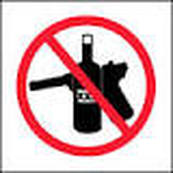
TEN COMMANDMENTS OF FIREARM SAFETY
1st Commandment of Firearm Safety
Always keep the muzzle pointed in a safe direction.
This is the most important gun safety rule. A safe direction is one in which an accidental discharge will not cause injury to yourself or others. Never allow your gun to point at anything you don't intend to shoot. Be especially careful when you're loading or unloading. Treat every gun as if it were loaded. And make it a habit to know where your muzzle is pointed at all times, even when your firearm is unloaded.
No one will be injured by an accidental discharge if you keep your firearm pointed in a safe direction. It's as simple as that.
The Ten Commandments of Firearms Safety should be etched in your memory forever. Let them govern your actions wherever and whenever you're involved with firearms. In the woods. On the range. Or in your home. Please take time to review and understand these rules.
2nd Commandment of Firearm Safety
Firearms should be unloaded when not actually in use.
Load your firearm only when you're in the field or on the target range and ready to fire. Never let a loaded gun out of your sight or out of your hands. Unload it as soon as you're finished shooting - before you bring it into your car, camp, or home. Remember, unloading your firearm means unloading it completely, so there is no ammunition in the chamber or in the magazine.
Before handling a firearm or passing it to someone else, visually check the chamber, receiver and magazine to be certain they do not contain ammunition. Always keep the gun's action open when not in use. Never assume a gun is unloaded even if you were the last person to use it. Always check for yourself.
Let common sense rule when you carry a loaded gun. If you're in any situation that could risk accidental discharge - such as crossing a fence, wading through a stream, or climbing a tree - always unload your gun. Never pull or push a loaded firearm toward yourself or another person. And never carry a loaded gun in a scabbard, detached holster or gun case.
Safe storage of firearms is just as critical as safe handling. Never store guns loaded and be sure to keep your firearms in a secure place where no one can get their hands on them without your knowledge.
Take special care if there are children around. Kids are fascinated by guns. It's a natural curiosity that can have tragic consequences when not properly supervised. Store your firearms in a locked gun safe or some other location that physically bars a child from gaining access. Ammunition should be stored and locked in a location separate from your firearms. Never leave an unsecured firearm or ammunition in a closet, dresser drawer or under the bed. Remember, it is your responsibility to make sure that children and others unfamiliar with firearms cannot get access to your firearms and ammunition.
3rd Commandment of Firearm Safety
Don't rely on your gun's safety.
Treat every gun as if it can fire at any time, whether or not there's pressure on the trigger.
Your firearm has been carefully designed to maximize performance and safety. However, a gun's safety is a mechanical device and, like any mechanical device, it could fail.
Human error is a more likely reason for a gun safety to fail. By mistake, you may think the safety is on when it really isn't. Or the safety may have been disengaged without your knowledge. Or you could think your gun is unloaded when there's actually a cartridge or shell in it. A safety is not a substitute for common sense. It's merely a supplement to your proper handling of a firearm.
Don't touch the trigger on a firearm until you are ready to shoot. Keep your fingers away from the trigger when you're loading or unloading. And don't pull the trigger when the safety is engaged or positioned anywhere between safe and fire.
Read your instruction manual to understand the exact location and operation of your firearm's safety. Even when the safety is on, maintain control of your loaded firearm and control the direction of the muzzle. In other words, don't rely on your safety to justify careless handling. If your firearm's internal mechanisms are broken or have been altered, your firearm may fire even when the safety is on. Remember, you and your safe gun handling practices are your gun's best safety.
4th Commandment of Firearm Safety
Be sure of your target and what's beyond it.
You can't stop a shot in mid-air, so do not fire unless you know exactly where your shot is going and what it will strike. Never fire at a sound, a movement or a patch of color. A hunter in camouflage can easily be mistaken for a target by an impulsive shooter. Before you pull the trigger be absolutely sure of your target and what's behind it. Make sure your shot has a backstop such as a hillside or dense material like sand.
Remember, bullets can travel great distances with tremendous velocity. Know how far your shot will go if you miss your target or the bullet ricochets.
5th Commandment of Firearm Safety
Use Proper Ammunition.
Every firearm is designed to use a certain caliber or gauge of ammunition. Using the wrong ammunition, mixing ammunition or using improperly reloaded ammunition can cause serious personal injury or death. And it only takes one cartridge or shotshell of the incorrect caliber or gauge, or which has been improperly reloaded to destroy your firearm.
As a gun owner it's your responsibility to make sure the ammunition you use exactly matches the caliber or gauge of your gun. Refer to the instruction manual to find out the specific requirements of your firearm. Always read and heed the instructions on ammunition boxes.
Confusing shells or cartridges can cause serious personal injury or death and destroy your firearm. Examine your shells and cartridges closely and use only the precise caliber or gauge for your specific firearm.
For example, suppose you accidentally loaded a 20 ga. shell into a 12 ga. shotgun. Because the 20 ga. shell is too small for the chamber, the 20 ga. shell could travel down the barrel and get lodged in the bore. If you then loaded a standard 12 ga. shell behind it and fire, the 12 ga. shot will slam into the lodged 20 ga. shell and may cause the barrel to explode right in your hands. This is commonly called a 12/20 burst, and it can kill you.
Check all ammunition before you load it to make sure it matches your gun's requirements. Every cartridge and shell is head-stamped with its caliber or gauge for easy identification. Likewise, you'll find the caliber or gauge of your new firearm imprinted on the barrel.
Reloading Requires Extra Diligence.
If you're an ammunition reloader, you are responsible for personally assuring that the loads and components of your reloaded ammunition meet your gun's factory-tested standards. Never use ammunition which has been reloaded by someone else!
Many shooters handload as a hobby or to save money on commercial, factory-made ammunition. However, it requires a thorough knowledge of reloading procedures and a deep respect for the explosive potential of gunpowder.
Firearms are designed, manufactured and proof-tested to standards based on factory loaded ammunition. Handloaded or reloaded ammunition that deviates, either intentionally or inadequately, from load or component recommendations can be very dangerous. Reloaders must observe all possible safety precautions and practices related to the proper handling of explosives. Whether you're a seasoned reloader or just starting out, you should study the subject, watch reloading demonstrations and talk to experienced reloaders.
The first rule of reloading is to always follow the manufacturer's instructions for the components you're using. They'll tell you to follow certain guidelines. Namely:
The process of reloading exposes you to environmentally hazardous materials. Lead is the most common substance in bullets and shot. It is important to handle lead bullets and shot with extreme care. Work only in a well-ventilated area and always wash your hands after exposure and before eating. Never smoke while reloading.
Primers and powders are also highly toxic and flammable. So after reloading, be sure to clean up all materials from your work area. Don't leave primer or powder spills anywhere on the floor or bench top. Dispose of all waste materials in accordance with the manufacturer's recommendations.
Finally, when reloading or handloading concentrate on what you're doing at all times. Do not be distracted by talking to others, listening to the radio or watching TV while reloading. Never reload after or while consuming alcoholic beverages or drugs of any kind. You are working with extremely hazardous materials and you can't risk even a few seconds of distraction. Remember, if you reload, you are the ammunition manufacturer and you are responsible for the performance and safety of your reloaded ammunition.
6th Commandment of Firearm Safety
If your gun fails to fire when the trigger is pulled, handle with care.
If for some reason the ammunition doesn't fire when you pull the trigger, stop and remember the 1st Commandment of Firearm Safety - always keep the muzzle pointed in a safe direction. Keep your face away from the breech, then put the safety on, carefully open the action, unload the firearm and dispose of the cartridge safely. Remember anytime there's a shell in the chamber, your gun is loaded and ready to use. Even if you tried to shoot and your gun didn't fire, treat your firearm as if it could still discharge.
7th Commandment of Firearm Safety
Always wear eye and ear protection when shooting.
Your sight and hearing risk injury from shooting and should be protected at all times.
Wear protective shooting glasses to guard against falling shot, clay target chips, powder residue, ruptured cartridge cases and even twigs and branches in the field. Also be sure to wear eye protection when you're disassembling or cleaning a gun so that tensioned parts (like springs) and cleaning solvents don't come in contact with your eyes.
Continued exposure to shooting noise can permanently damage your hearing. On the range, where shooting volume is the loudest, be sure to use the maximum protection of a headset. And learn to use earplugs in the field, especially in confined locations like duck blinds.
8th Commandment of Firearm Safety
Be sure the barrel is clear of obstructions before shooting.
Before loading your gun, open the action and make sure there's no ammunition in the chamber or magazine. Check the barrel for any obstructions or debris. Even a small amount of snow, mud, excess lubricant or grease in the bore can dangerously increase pressure and cause the barrel to bulge or burst when firing. Use a cleaning rod and patch to wipe away anti-rust compounds or any other residues or obstructions in the barrel. Never try to shoot out an obstruction by loading another shell and firing!
When firing, rely on your instincts. If the noise or recoil from your firearm seems off or weak, stop everything, unload your firearm and be sure nothing is lodged in the barrel. Remember the 12/20 burst? That's what can happen when the barrel is obstructed. So always be sure you're using the correct ammunition in your firearm and that it's free of obstructions.
9th Commandment of Firearm Safety
Don't alter or modify your gun and have it serviced regularly.
Your firearm has been designed to operate according to certain factory specifications. You'll jeopardize your safety and that of others around you by attempting to alter its trigger, safety or other mechanisms. So never alter or modify your firearm in any way.
Like any mechanical device, a firearm is subject to wear. It must be maintained and periodically serviced to assure optimum safety and performance.
Don't allow anyone to service, repair or modify your firearm unless they are a qualified service facility.
Proper cleaning and lubrication are also important to firearm maintenance and are necessary to assure accuracy, safety, and reliability. Before cleaning, always make sure that your gun is completely unloaded. And always clean the barrel from the chamber end to the muzzle when possible.
Make it a practice to clean your bore every time you're going to shoot. Be sure to clean your entire gun before and after long-term storage, and no less than once a year. It's also important to clean your gun whenever it's been exposed to adverse conditions such as rain, dirt, mud, snow, sleet or saltwater.
For safe and dependable operation of your firearm, all parts of your gun must be properly cleaned and lubricated. Periodically inspect the internal workings of your firearm to be sure they're clean and free of rust, unwanted dirt and debris.
Use recommended lubricants on your gun and do not over-lubricate. Excessive use of a non-recommended lubricant could adversely affect the function and safe operation of your firearm. Remember, you are responsible for the proper care and maintenance of your firearm. Failure to properly maintain your firearm can not only damage or ruin your firearm, it can expose you and others to unnecessary risks of personal injury or death.
10th Commandment of Firearm Safety
Learn the mechanical and handling characteristics of the firearm you are using.
Not all guns are alike. They have different mechanical characteristics that dictate how you should carry and handle them. Anyone who plans to use a firearm should first become totally familiar with the type of firearm it is and the safe handling procedures for loading, unloading, carrying, shooting and storing it.
Before you even unpack your new firearm, read the instruction manual from cover to cover and familiarize yourself with the different component parts of the gun. Then read, understand and follow the ten commandments of safety.
Shoot Sober
There's one other rule that must be followed when handling firearms. In fact, respect for this rule is necessary in order to effectively practice the Ten Commandments of Firearm Safety. The rule is: SHOOT SOBER!
Alcohol, drugs and guns are a deadly combination. Never consume anything that would even mildly impair your judgment or physical coordination when you're using a firearm. A staggering percentage of the shooting accidents that occur every year involve alcohol or drugs. Be smart. Shoot sober and stay alive.
1st Commandment of Firearm Safety
Always keep the muzzle pointed in a safe direction.
This is the most important gun safety rule. A safe direction is one in which an accidental discharge will not cause injury to yourself or others. Never allow your gun to point at anything you don't intend to shoot. Be especially careful when you're loading or unloading. Treat every gun as if it were loaded. And make it a habit to know where your muzzle is pointed at all times, even when your firearm is unloaded.
No one will be injured by an accidental discharge if you keep your firearm pointed in a safe direction. It's as simple as that.
The Ten Commandments of Firearms Safety should be etched in your memory forever. Let them govern your actions wherever and whenever you're involved with firearms. In the woods. On the range. Or in your home. Please take time to review and understand these rules.
2nd Commandment of Firearm Safety
Firearms should be unloaded when not actually in use.
Load your firearm only when you're in the field or on the target range and ready to fire. Never let a loaded gun out of your sight or out of your hands. Unload it as soon as you're finished shooting - before you bring it into your car, camp, or home. Remember, unloading your firearm means unloading it completely, so there is no ammunition in the chamber or in the magazine.
Before handling a firearm or passing it to someone else, visually check the chamber, receiver and magazine to be certain they do not contain ammunition. Always keep the gun's action open when not in use. Never assume a gun is unloaded even if you were the last person to use it. Always check for yourself.
Let common sense rule when you carry a loaded gun. If you're in any situation that could risk accidental discharge - such as crossing a fence, wading through a stream, or climbing a tree - always unload your gun. Never pull or push a loaded firearm toward yourself or another person. And never carry a loaded gun in a scabbard, detached holster or gun case.
Safe storage of firearms is just as critical as safe handling. Never store guns loaded and be sure to keep your firearms in a secure place where no one can get their hands on them without your knowledge.
Take special care if there are children around. Kids are fascinated by guns. It's a natural curiosity that can have tragic consequences when not properly supervised. Store your firearms in a locked gun safe or some other location that physically bars a child from gaining access. Ammunition should be stored and locked in a location separate from your firearms. Never leave an unsecured firearm or ammunition in a closet, dresser drawer or under the bed. Remember, it is your responsibility to make sure that children and others unfamiliar with firearms cannot get access to your firearms and ammunition.
3rd Commandment of Firearm Safety
Don't rely on your gun's safety.
Treat every gun as if it can fire at any time, whether or not there's pressure on the trigger.
Your firearm has been carefully designed to maximize performance and safety. However, a gun's safety is a mechanical device and, like any mechanical device, it could fail.
Human error is a more likely reason for a gun safety to fail. By mistake, you may think the safety is on when it really isn't. Or the safety may have been disengaged without your knowledge. Or you could think your gun is unloaded when there's actually a cartridge or shell in it. A safety is not a substitute for common sense. It's merely a supplement to your proper handling of a firearm.
Don't touch the trigger on a firearm until you are ready to shoot. Keep your fingers away from the trigger when you're loading or unloading. And don't pull the trigger when the safety is engaged or positioned anywhere between safe and fire.
Read your instruction manual to understand the exact location and operation of your firearm's safety. Even when the safety is on, maintain control of your loaded firearm and control the direction of the muzzle. In other words, don't rely on your safety to justify careless handling. If your firearm's internal mechanisms are broken or have been altered, your firearm may fire even when the safety is on. Remember, you and your safe gun handling practices are your gun's best safety.
4th Commandment of Firearm Safety
Be sure of your target and what's beyond it.
You can't stop a shot in mid-air, so do not fire unless you know exactly where your shot is going and what it will strike. Never fire at a sound, a movement or a patch of color. A hunter in camouflage can easily be mistaken for a target by an impulsive shooter. Before you pull the trigger be absolutely sure of your target and what's behind it. Make sure your shot has a backstop such as a hillside or dense material like sand.
Remember, bullets can travel great distances with tremendous velocity. Know how far your shot will go if you miss your target or the bullet ricochets.
5th Commandment of Firearm Safety
Use Proper Ammunition.
Every firearm is designed to use a certain caliber or gauge of ammunition. Using the wrong ammunition, mixing ammunition or using improperly reloaded ammunition can cause serious personal injury or death. And it only takes one cartridge or shotshell of the incorrect caliber or gauge, or which has been improperly reloaded to destroy your firearm.
As a gun owner it's your responsibility to make sure the ammunition you use exactly matches the caliber or gauge of your gun. Refer to the instruction manual to find out the specific requirements of your firearm. Always read and heed the instructions on ammunition boxes.
Confusing shells or cartridges can cause serious personal injury or death and destroy your firearm. Examine your shells and cartridges closely and use only the precise caliber or gauge for your specific firearm.
For example, suppose you accidentally loaded a 20 ga. shell into a 12 ga. shotgun. Because the 20 ga. shell is too small for the chamber, the 20 ga. shell could travel down the barrel and get lodged in the bore. If you then loaded a standard 12 ga. shell behind it and fire, the 12 ga. shot will slam into the lodged 20 ga. shell and may cause the barrel to explode right in your hands. This is commonly called a 12/20 burst, and it can kill you.
Check all ammunition before you load it to make sure it matches your gun's requirements. Every cartridge and shell is head-stamped with its caliber or gauge for easy identification. Likewise, you'll find the caliber or gauge of your new firearm imprinted on the barrel.
Reloading Requires Extra Diligence.
If you're an ammunition reloader, you are responsible for personally assuring that the loads and components of your reloaded ammunition meet your gun's factory-tested standards. Never use ammunition which has been reloaded by someone else!
Many shooters handload as a hobby or to save money on commercial, factory-made ammunition. However, it requires a thorough knowledge of reloading procedures and a deep respect for the explosive potential of gunpowder.
Firearms are designed, manufactured and proof-tested to standards based on factory loaded ammunition. Handloaded or reloaded ammunition that deviates, either intentionally or inadequately, from load or component recommendations can be very dangerous. Reloaders must observe all possible safety precautions and practices related to the proper handling of explosives. Whether you're a seasoned reloader or just starting out, you should study the subject, watch reloading demonstrations and talk to experienced reloaders.
The first rule of reloading is to always follow the manufacturer's instructions for the components you're using. They'll tell you to follow certain guidelines. Namely:
- Don't mix or substitute powders or primers.
- Don't use unknown or substandard components.
- Use only suitable components that have been factory tested by reputable ammunition, powder and bullet manufacturers.
- Always be sure to use the manufacturer's recommended recipe when reloading.
The process of reloading exposes you to environmentally hazardous materials. Lead is the most common substance in bullets and shot. It is important to handle lead bullets and shot with extreme care. Work only in a well-ventilated area and always wash your hands after exposure and before eating. Never smoke while reloading.
Primers and powders are also highly toxic and flammable. So after reloading, be sure to clean up all materials from your work area. Don't leave primer or powder spills anywhere on the floor or bench top. Dispose of all waste materials in accordance with the manufacturer's recommendations.
Finally, when reloading or handloading concentrate on what you're doing at all times. Do not be distracted by talking to others, listening to the radio or watching TV while reloading. Never reload after or while consuming alcoholic beverages or drugs of any kind. You are working with extremely hazardous materials and you can't risk even a few seconds of distraction. Remember, if you reload, you are the ammunition manufacturer and you are responsible for the performance and safety of your reloaded ammunition.
6th Commandment of Firearm Safety
If your gun fails to fire when the trigger is pulled, handle with care.
If for some reason the ammunition doesn't fire when you pull the trigger, stop and remember the 1st Commandment of Firearm Safety - always keep the muzzle pointed in a safe direction. Keep your face away from the breech, then put the safety on, carefully open the action, unload the firearm and dispose of the cartridge safely. Remember anytime there's a shell in the chamber, your gun is loaded and ready to use. Even if you tried to shoot and your gun didn't fire, treat your firearm as if it could still discharge.
7th Commandment of Firearm Safety
Always wear eye and ear protection when shooting.
Your sight and hearing risk injury from shooting and should be protected at all times.
Wear protective shooting glasses to guard against falling shot, clay target chips, powder residue, ruptured cartridge cases and even twigs and branches in the field. Also be sure to wear eye protection when you're disassembling or cleaning a gun so that tensioned parts (like springs) and cleaning solvents don't come in contact with your eyes.
Continued exposure to shooting noise can permanently damage your hearing. On the range, where shooting volume is the loudest, be sure to use the maximum protection of a headset. And learn to use earplugs in the field, especially in confined locations like duck blinds.
8th Commandment of Firearm Safety
Be sure the barrel is clear of obstructions before shooting.
Before loading your gun, open the action and make sure there's no ammunition in the chamber or magazine. Check the barrel for any obstructions or debris. Even a small amount of snow, mud, excess lubricant or grease in the bore can dangerously increase pressure and cause the barrel to bulge or burst when firing. Use a cleaning rod and patch to wipe away anti-rust compounds or any other residues or obstructions in the barrel. Never try to shoot out an obstruction by loading another shell and firing!
When firing, rely on your instincts. If the noise or recoil from your firearm seems off or weak, stop everything, unload your firearm and be sure nothing is lodged in the barrel. Remember the 12/20 burst? That's what can happen when the barrel is obstructed. So always be sure you're using the correct ammunition in your firearm and that it's free of obstructions.
9th Commandment of Firearm Safety
Don't alter or modify your gun and have it serviced regularly.
Your firearm has been designed to operate according to certain factory specifications. You'll jeopardize your safety and that of others around you by attempting to alter its trigger, safety or other mechanisms. So never alter or modify your firearm in any way.
Like any mechanical device, a firearm is subject to wear. It must be maintained and periodically serviced to assure optimum safety and performance.
Don't allow anyone to service, repair or modify your firearm unless they are a qualified service facility.
Proper cleaning and lubrication are also important to firearm maintenance and are necessary to assure accuracy, safety, and reliability. Before cleaning, always make sure that your gun is completely unloaded. And always clean the barrel from the chamber end to the muzzle when possible.
Make it a practice to clean your bore every time you're going to shoot. Be sure to clean your entire gun before and after long-term storage, and no less than once a year. It's also important to clean your gun whenever it's been exposed to adverse conditions such as rain, dirt, mud, snow, sleet or saltwater.
For safe and dependable operation of your firearm, all parts of your gun must be properly cleaned and lubricated. Periodically inspect the internal workings of your firearm to be sure they're clean and free of rust, unwanted dirt and debris.
Use recommended lubricants on your gun and do not over-lubricate. Excessive use of a non-recommended lubricant could adversely affect the function and safe operation of your firearm. Remember, you are responsible for the proper care and maintenance of your firearm. Failure to properly maintain your firearm can not only damage or ruin your firearm, it can expose you and others to unnecessary risks of personal injury or death.
10th Commandment of Firearm Safety
Learn the mechanical and handling characteristics of the firearm you are using.
Not all guns are alike. They have different mechanical characteristics that dictate how you should carry and handle them. Anyone who plans to use a firearm should first become totally familiar with the type of firearm it is and the safe handling procedures for loading, unloading, carrying, shooting and storing it.
Before you even unpack your new firearm, read the instruction manual from cover to cover and familiarize yourself with the different component parts of the gun. Then read, understand and follow the ten commandments of safety.
Shoot Sober
There's one other rule that must be followed when handling firearms. In fact, respect for this rule is necessary in order to effectively practice the Ten Commandments of Firearm Safety. The rule is: SHOOT SOBER!
Alcohol, drugs and guns are a deadly combination. Never consume anything that would even mildly impair your judgment or physical coordination when you're using a firearm. A staggering percentage of the shooting accidents that occur every year involve alcohol or drugs. Be smart. Shoot sober and stay alive.
Ten Commandments of Hunting Safety
1. Treat every firearm with the same respect due a loaded firearm.
2. Control the direction of your firearm's muzzle.
3. Be sure of your target and what is beyond it.
4. Be sure the barrel and action are clear of obstructions.
5. Unload firearms when not in use.
6. Never point a firearm at anything you do not intend to shoot.
7. Never climb a fence or tree, or jump a ditch or log, with a loaded firearm.
8. Never shoot a bullet at a flat, hard surface or water.
9. Store firearms and ammunition separately.
10. Avoid alcoholic beverages or other mood-altering drugs before or while shooting.
1. Treat every firearm with the same respect due a loaded firearm.
2. Control the direction of your firearm's muzzle.
3. Be sure of your target and what is beyond it.
4. Be sure the barrel and action are clear of obstructions.
5. Unload firearms when not in use.
6. Never point a firearm at anything you do not intend to shoot.
7. Never climb a fence or tree, or jump a ditch or log, with a loaded firearm.
8. Never shoot a bullet at a flat, hard surface or water.
9. Store firearms and ammunition separately.
10. Avoid alcoholic beverages or other mood-altering drugs before or while shooting.
Ten Commandments of Firearm Safety and Ten Commandments of Hunting Safety download
| ten_commands_firearm_hunting_safety_2.pdf | |
| File Size: | 73 kb |
| File Type: | |
The Code download
| safety_-_the_code.pdf | |
| File Size: | 95 kb |
| File Type: | |
Additional firearm safety information- Beginner Firearm Safety, From Safe Storage to Safe Shooting:
www.snipercountry.com/beginner-firearm-safety-from-safe-storage-to-safe-shooting/
www.snipercountry.com/beginner-firearm-safety-from-safe-storage-to-safe-shooting/
